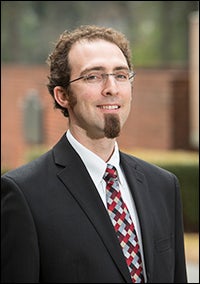THIRD IN STATE
ECU shows growth in research funding
Following three years of significant growth in research dollars, East Carolina University now ranks third among the state’s public universities in research funding.
From 2011-2014, ECU averaged a 17 percent annual growth rate in external research dollars, hitting $38.3 million in 2013, according to the National Science Foundation’s annual Higher Education Research and Development Survey. That placed ECU behind only the University of North Carolina at Chapel Hill and N.C. State University among the schools in the UNC system.
ECU’s growth rate outpaces the average rate of 3 percent among the university’s peer institutions nationwide, according to Michael Van Scott, ECU interim associate vice chancellor for research and chief research officer. He presented the research figures to the ECU Board of Trustees last month.

Ben Fraser, chair of ECU’s Department of Foreign Languages and Literatures
“It takes a concerted effort over many years to grow a research program,” said Van Scott. During the last decade, ECU improved research facilities, recruited research-active faculty members and accelerated acquisition of external, or extramural, funding. The investment in support of new faculty amounts to $2.7 million annually, he said, and it’s paying dividends.
“Even with the cuts in state appropriations, the university has continued to invest funds to seed research by promising faculty members,” Van Scott said. “A portion of the indirect costs recovered each year on extramural grants is distributed to the faculty and units where the research was conducted. These funds are used to further invest in the research enterprise. This amounts to about $2 million that seeds future research grants.
“We also invest about $300,000 to $500,000 each year to support new investigative teams that have ideas for projects that can be competitive for extramural funding and to provide time for faculty members to write competitive grant proposals,” he added.
One example is Ben Fraser, who joined ECU last July as professor of Hispanic studies and chair of foreign languages and literatures. ECU’s support is helping him create an interdisciplinary team focusing on innovative digital projects.
“The internal start-up grant I received for (academic year) 2015-16 is helping me in setting up a digital humanities lab,” he said, in partnership with several faculty members from his and other departments.
In addition, the ECU Division of Research and Graduate Studies is offering $30,000 for a one-time competitive faculty grant program this summer to support digital projects that link disciplines, target national grants and engage community partnerships.
Van Scott credited academic departments at ECU for managing faculty workloads to make the most of research opportunities. Some tenure-track faculty members and non-tenure track faculty take on greater teaching loads to free up research-active faculty who can compete for external funds.
“The faculty members that are taking on more teaching are doing a great job, as indicated by national benchmarks for the value added to students attending ECU,” he said. “Faculty that have been freed up to develop research programs are being accountable for the time they are provided. To see increases in research expenditures in this environment reflects a lot of hard work by the faculty as a whole within a team environment.”
Of the $38.3 million ECU received in 2013, 80 percent came from external sources – 73 percent of that from competitive grants and contracts awarded to faculty members and the remainder from foundations. Nationally, only 77 percent of these funds come from external sources, with 71 percent of that from competitive grants and contracts, according to NSF statistics.
ECU’s recent performance comes at a time when total funding for research at universities, adjusted for inflation, has been flat, and federal funding has decreased, according to NSF statistics.
For several reasons, Van Scott expects research expenditures for the next two years to be similar to 2012 levels of about $32 million before growing again. The recent tuition increase ECU trustees approved “should provide much-needed salary support for our faculty that are productive in research as well as teaching,” he said.